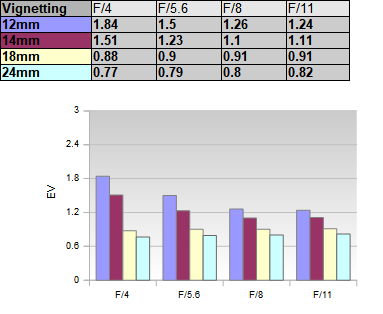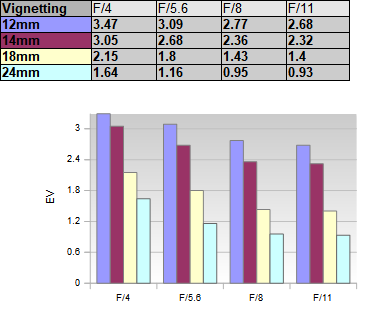|
Sony FE 12-24mm f/4 G (SEL1224G) - Review / Test - Analysis |
|
Lens Reviews -
Sony Alpha (Full Format)
|
|
Page 2 of 3

Distortion
As usual there are two sides of the story here when it comes to Sony mirrorless lenses - with activated or deactivated image auto-correction. With activated correction, the image distortions are generally moderate. They stay just below 1% barrel distortion at 12mm and beyond they are rather irrelevant.
The situation changes when looking at the RAW distortions. At 12mm there are very strong barrel distortions of 3.8%. However, please note that this is in line with similar lenses in this class. The distortions are moderate at 14mm but increase again to medium (and less pleasant) pincushion distortions toward the long end of the zoom range.
Vignetting
We have a similar story in terms of vignetting. With activated vignetting correction, the light falloff is reasonably well controlled for an ultra-wide lens. The vignetting is still easily visible at 12mm with a peak of 1.8EV (f-stops) at f/4 and the issue is only slightly reduced to 1.2EV when stopping down to f/11. The vignetting characteristic eases the more you zoom out. Please note that there's always a certain degree of so-called "natural" vignetting with ultra-wide lenses so it unrealistic to expect zero vignetting anyway.
 That being said, things aren't so pleasant when looking at the RAW vignetting. It is quite extreme at 12mm & 14mm f/4 with a light falloff of more than 3EV (f-stops). Stopping down to f/11 doesn't help too much (2EV). As expected it is a lesser issue at longer focal lengths, of course.
Thus generally it is a good idea to activate vignetting correction with this lens.
That being said, things aren't so pleasant when looking at the RAW vignetting. It is quite extreme at 12mm & 14mm f/4 with a light falloff of more than 3EV (f-stops). Stopping down to f/11 doesn't help too much (2EV). As expected it is a lesser issue at longer focal lengths, of course.
Thus generally it is a good idea to activate vignetting correction with this lens.

MTF (resolution)
High resolution sensors tend to be challenging for many lenses especially in the ultra-wide segment but the Sony FE 12-24mm f/4 G is capable of delivering very decent results. The center quality is outstanding at 12mm and large aperture settings. The border quality is also very good and the corners are managing to stay at least on a good level. The most extreme corner (just beyond what we define as corner which is already far out) is a tad soft though. You should avoid small apertures unless really needed because diffraction has already a strong impact at f/11. The performance is similar at 14mm. The sweet spot of the lens is reached at 18mm where the corners are seeing a boost to very good levels (just). Traditionally the "long" end is the weakest spot in an ultra-wide zoom lens. While the performance is somewhat reduced in this case, it remains on a quite high level from f/5.6 onward at least.
The centering quality of the tested sample was very good.
Please note that the MTF results are not directly comparable across the different systems!
Below is a simplified summary of the formal findings. The chart shows line widths per picture height (LW/PH) which can be taken as a measure for sharpness.
If you want to know more about the MTF50 figures you may check out the corresponding Imatest Explanations
Chromatic Aberrations (CAs)
The amount of lateral chromatic aberrations (color shadows at the image borders) is very good for a lens in this class. The average CA pixel width stays around the 1.2px mark in the 12-18mm range and increases only slightly at 24mm.

|